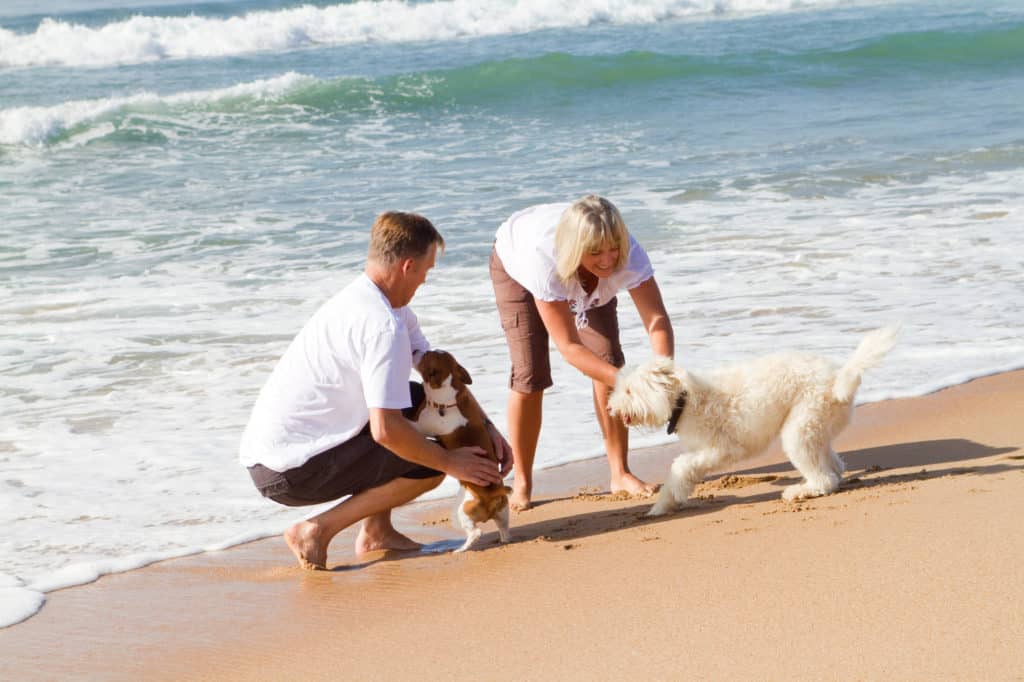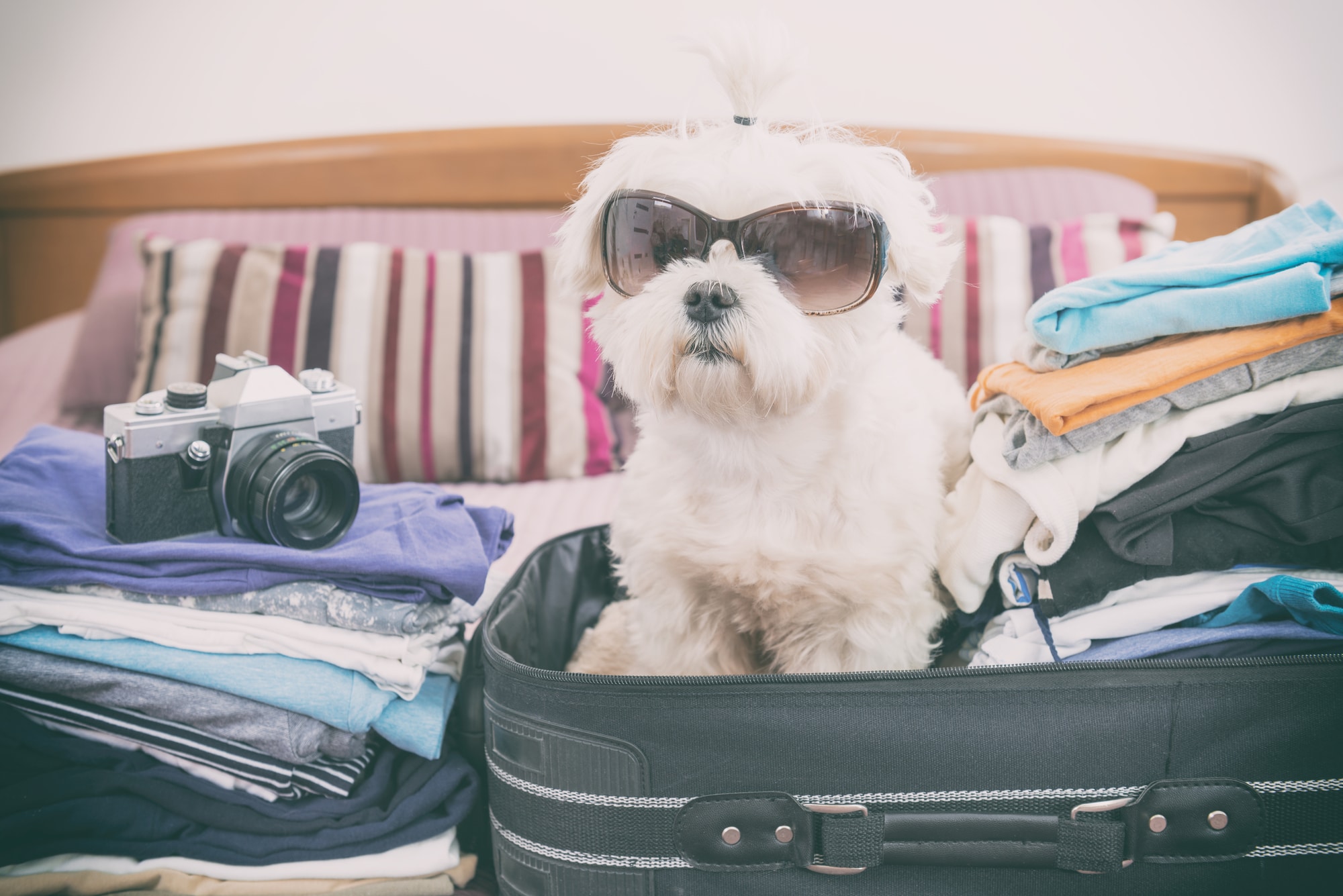Vacation with dog planned? (What should you consider?)
- Claudia Weise
- Updated: 2023-08-11
Want to take your dog with you when you travel? Then you should consider and plan a few things. We will show you what exactly in this article. So get excited!

Go on vacation with your tail wagging.
The sun beckons, the distance calls... When the sun is warm and the call of adventure is in the air, for many of us, there is nothing better than packing our bags and heading out on vacation.
But as we look forward to new places and experiences, we often cast a wistful glance at our four-legged friend, who looks back at us with wide-eyed wonder.
No dog likes to be separated from its human. On the other hand, it is not easy to travel without your faithful companion. So why not experience the adventure with your best friend by your side?
But before you and your furry friend cross the border and head off to a new country, there are a few things to consider. Here is our guide to an unforgettable vacation with your dog.
All About Traveling With Your Dog

For many dog owners, it is a given that their four-legged friend will not be left alone on vacation. Traveling with a dog can be a wonderful experience for you and your furry friend if you are well-prepared and informed. Especially when traveling abroad, there are a few things to keep in mind.
General tips:
- Travel arrangements: It never hurts to check with your vet before you leave. Some countries even require certain vaccinations or health certificates.
- Safe transportation: Whether you're traveling by car, train or plane, make sure your dog is safe and comfortable.
- Destination: Check in advance for dog-friendly accommodations and attractions. Dogs are not welcome everywhere.
Choosing the Destination
Vacationing with a dog can be an unforgettable experience. But it does take a little planning and preparation.
When choosing a vacation spot, especially in the summer, you should look for official dog beaches. Some websites allow you to search for dog beaches or lakes, depending on where you want to go.
You can also find out about dog-friendly cottages, apartments and hotels. The fact that dogs are allowed in hotels does not mean that they are welcome.
It's best to find out before you book your accommodation. After all, you don't want your pet to miss out.
Taking Dogs Abroad - What to Consider?
Be sure to check the entry requirements for each country, and always consider the needs of your dog. With the right preparation, nothing will stand in the way of your adventure together!
Here is a brief overview:
- Switzerland: Valid EU pet passport, microchip and rabies vaccination required. Special permit is required for some dog breeds.
- Spain: In addition to the EU pet passport, some regions have restrictions on certain breeds. It is best to check in advance.
- France: EU pet passport and rabies vaccination required. Some dog breeds are considered dangerous and cannot be imported without special permission.
- Denmark: Your dog will need an EU pet passport and a microchip. Certain breeds are prohibited in Denmark.
- Belgium: An EU pet passport, microchip and rabies vaccination are required.
- Netherlands: In addition to EU regulations, there are restrictions on some breeds that are considered dangerous.
- Austria: An EU pet passport, microchip and rabies vaccination are mandatory. A muzzle is often required on public transportation.
- Poland: EU pet passport and current rabies vaccination required.
- Italy: EU pet passport, microchip and rabies vaccination required. Check local regulations and breed restrictions.
- Czech Republic: EU pet passport, microchip and rabies vaccination required. A muzzle may be required on public transportation and in certain locations.
- Slovenia: Again, an EU pet passport, microchip and rabies vaccination are required.
- Travel to the USA with your dog: If you plan to travel to the USA with your dog, there are a number of regulations and precautions you should be aware of:
- General eligibility requirements:
Exact regulations may vary from state to state.
In general, dogs must appear healthy upon entry. If they appear sick, an examination by a U.S. Department of Agriculture (USDA) veterinarian may be required. - Vaccinations:
A valid rabies vaccination is usually required. Some states have specific requirements as to how long before entry the vaccination must be given. Generally, a rabies vaccination given at least 30 days prior to entry is acceptable.
It is recommended that you carry an international certificate of vaccination for your dog that lists all required vaccinations. - Quarantine:
Most U.S. states do not require quarantine for healthy dogs with current rabies vaccinations. However, there are exceptions, particularly for travel to Hawaii. Hawaii has very strict quarantine requirements to keep the islands rabies free. - Microchip:
Although a microchip is not always required, it is strongly recommended. Make sure the microchip is compatible with international standards. - Health Certificate:
A health certificate issued by a veterinarian (usually no more than 10 days prior to departure) may be required. - Transportation:
Be sure to check the shipping requirements of the airline you are traveling with. Many airlines have specific rules regarding the size and type of kennel, feeding, and in-flight care. - Local regulations:
Some states or cities have restrictions on certain breeds of dogs. It is advisable to find out in advance. - Accommodation:
Not all hotels and vacation rentals in the USA are dog friendly. It is important to check in advance and book dog-friendly accommodations if necessary. - Environmental conditions:
Depending on your destination in the U.S., you may also want to consider environmental conditions, such as high temperatures in desert regions or harsh winter conditions in northern states. - Return journey:
Think about how you will return to your home country after a stay in the U.S. and the entry requirements of your home country.
It is important to be well informed in advance and to have all the necessary documents with you to avoid problems when entering the country. In general, it is advisable to consider the individual needs and comfort of your dog in addition to the official regulations.
→ For detailed and up-to-date information about traveling with dogs in different countries, it is best to consult official websites and trusted sources.
Here are some steps and resources that can help you do that:
- Embassies and Consulates: The embassy or consulate of the destination country can often provide detailed information on entry requirements for animals.
- Official tourism websites: Many countries have official tourism websites with information about bringing pets.
- Veterinarians and animal welfare organizations: Often, local veterinarians or national humane societies are a good source of information as they deal with these issues on a regular basis.
- EU Animal Health website: For travel within the EU, the EU Animal Health website provides detailed information on the requirements for travelling with pets between Member States.
- Travel and vacation forums: There are many forums and travel websites where travelers share their experiences. Sites like TripAdvisor can sometimes provide useful tips from other dog owners who have traveled to the country you are interested in.
- Dog associations and clubs: National and international canine associations and clubs can often provide specific information or resources.
Remember that regulations may change over time. It is always a good idea to check the information on a regular basis and, if in doubt, contact the authorities directly.
It is also a good idea to check well in advance of departure to ensure that vaccinations, documents, and other preparations are in place.
Once you've chosen a dog-friendly destination, the next question is how to get you and your dog there.
Here is a small overview of the available means of transportation:
4 Possible Means of Transportation
1) Dog in Car
The easiest and most comfortable way for your dog to travel is in the car. Most of the time, your dog will be used to the car and will not find the trip too strange. It also gives you the opportunity to stop more often and give your pet the exercise it needs. It is a good idea to take your pet's favorite blanket with you in the car. Most importantly, never leave your dog alone in the car! A closed car heats up in a few minutes in the summer and can become a death trap for humans and animals. If you choose the car as a means of transportation, you should choose one of the following ways to secure your dog. For small dogs, it is sufficient to secure them with their harness through a special seat belt on the back seat. For larger dogs, it is recommended to either secure the trunk with a partition or net, or to purchase a carrier. The cage allows the dog to move around and stand up. If you choose a carrier, make sure it is the right size and made of good quality material. You should make sure that it is sufficiently secure so that the animal's well-being is not compromised. In addition, there are high fines if dogs are not sufficiently secured. Up to 75 Euro and one point in Flensburg are possible.
For the best way to transport your dog in the car, read this article: Transporting a Dog in the Car? (You Need to Know)
2) Dog in Camper
The same rules apply to campers as to cars. When renting a motorhome, ask if dogs are allowed. There are special rental portals that offer motorhomes with kennels already built in and areas separated by fences for dog owners. You can find them for example under "Waumobil" or "Camper Dogs".
3) Dog on Train
In principle, the train is also a pleasant means of transportation for your four-legged friend. Especially if you have experience with subways or commuter trains on shorter routes. Muzzles and leashes are mandatory on Deutsche Bahn. You also need to buy a ticket for your pet. With a few exceptions, this costs half the fare. Smaller dogs, up to the size of a house cat, can be carried free of charge in a carrier. Be prepared to travel by train. It is important to have treats for relaxation, as well as poop bags and wipes for emergencies. If you are traveling abroad, be sure to check local regulations regarding train travel.
4) Dog on a Plane
For more distant destinations, air travel is unfortunately unavoidable. Your dog will not like it. So think carefully about whether you want him to travel by air. Before you book your tickets, there are two things you should consider. First, is your dog's breed suitable for air travel? Not all breeds can fly. Second, does the airline allow dogs on the flight, and if so, what are the rules? Each airline has a different policy regarding pets. Smaller dogs up to a certain weight may be carried in the cabin in an appropriate carrier. Larger dogs must be transported in a kennel in the cargo hold. Make sure the kennel is large enough for your pet to stand up between flights. You should also provide dry food and water. It can get very cold in the cargo hold. It is best to pack the kennel well so that your pet does not freeze while sleeping. It is important to notify the airline as early as possible that you are bringing your pet. Each aircraft has limited capacity for pets in the cabin and cargo hold. Be sure to check your destination's import, export and animal welfare regulations to avoid any unpleasant surprises at the airport. Depending on the size of the dog and the destination, the cost of a flight can range from €35 to €350.
Have You Thought About That?
Before you travel with your dog, it is important to have an EU pet passport, a good first aid kit and a packing list. Here are the most important things in a nutshell:
EU Pet Passport
If traveling abroad, your dog will need an EU pet passport. This can be issued by your vet. The cost is approximately 10 to 15 Euros. The passport is used to identify your pet and document its vaccinations. The most important is the rabies vaccination. Make sure your pet has a valid rabies vaccination. The date of the vaccination must be legible.
Dog Travel Pharmacy
Your faithful companion also needs its own First Aid Kit.
Be sure to consult your veterinarian before traveling. He can give you the most important information depending on the region. He can also give you a selection of necessary medications.
Otherwise, regardless of the region you are traveling in, you should bring a first aid kit, tick tweezers, and a remedy for mosquitoes and ticks.
To help you know what to look for in a travel pharmacy, we have put together a short and informative checklist for you.
| CHECKLIST "EMERGENCY KIT" FOR ON THE ROAD | ||
|---|---|---|
| Subject | Available? | Comments |
| Activated carbon | ||
| Gauze bandages | ||
| Fixation bandages | ||
| Command line | ||
| Pressure dressing | ||
| Self adhesive bandage | ||
| Bandage scissors | ||
| Wound ointment | specially for dogs | |
| Tweezers | for glass splinters etc. | |
| Tick Pliers | ||
| Phone number from vet | ||
| Telephone number of the emergency veterinary service | ||
Packing List
Now, of course, it's time to pack, not only for you, but also for your dog. To make packing for your dog easier, you can follow this list. In addition to the first aid kit and the EU pet passport, the following items should not be missing in the "dog suitcase":
- feeding and drinking bowls
- ceiling
- basket
- Exhausting
- leash
- tableware
- brush
- shampoo
- excrement bag
- dog toys
- muzzle if necessary
4 Alternatives to Vacation With Dog

Of course, not every vacation is ideal for your loyal companion. A city trip at high speed is hardly suitable for a dog. The hot summer months are especially dangerous.
You should also avoid taking your dog on long flights. So if you are planning something big, like a backpacking trip through Thailand or South America, your four-legged friend should stay at home.
But where to put the dog? Of course, it is best to have family or friends take care of your dog. That way, your dog will be with people he is familiar with and the adjustment will be less difficult for him.
Unfortunately, this opportunity does not always present itself. It's a good thing there are other options.
1. The Dog Sitter
As the name suggests, this is a person who takes care of your dog.
There are two basic options for the process: Either your pet stays home alone and the dog sitter picks him up for a walk, or he stays with the dog sitter while you are on vacation.
The first option has two drawbacks. First, your pet will be alone for long periods of the day and night.
Second, you must allow a stranger free access to your private home. However, your pet does not leave its familiar surroundings. It can move around in its familiar surroundings as usual.
If you choose the other option, your dog will always have company and will rarely be alone. But there is also a downside. A completely new environment means a lot of stress for your pet.
You should also keep in mind that anyone can offer themselves as a dog sitter. This means that their training and knowledge is not verified.
Of course, it would be convenient if someone could recommend a dog sitter based on good experience.
Otherwise, you can find a dog sitter through portals such as "gudog".
2. A Kennel
The dogs are kept in a kennel in larger groups. They are usually housed in a large kennel. They usually also have a fenced run.
A professional boarding kennel will only accept fully vaccinated dogs and will verify this with a vaccination certificate. The advantage of a boarding kennel is that your pet is cared for day and night.
You should visit several kennels before making a decision. If you have time, arrange a trial day to see how your dog reacts.
The unfamiliar environment and the unfamiliar company of other dogs can be stressful for your dog. The cost of boarding depends on the size of your dog and the length of your stay. It is usually between 15 and 20 euros per day.
3. The Dog Hotel
The main difference with kennels is that there are only a few places for hotel guests. This allows your pet to get much more attention.
In addition, there are better equipped rooms or lounges and exercise areas. Not infrequently, these dog hotels also have a grooming salon and a dog training school.
Your furry friend can have a little spa vacation here.
4. “If You Take My Animal, I’ll Take Your Animal”.
This free alternative for vacationers is an initiative of the German Animal Welfare Association with support from Pedigree and Whiskas. With the help of the members of the German Animal Welfare Association, a place for your pet will be found.
In return, you can adopt an animal from another member. The basic requirements are that the animal is vaccinated and has enough food.
You can find out about this at your local shelter and get involved. Keep in mind, however, that just like the dog sitter, anyone can participate.
No matter which option you choose, it is important to make your arrangements as early as possible. Good kennels fill up quickly.
Ultimately, the decision depends on your dog's specific needs and preferences, your own situation, and the details of your trip. The important thing is that you put your dog's well-being first and make sure he is comfortable.
Conclusion
On the road with four paws: An adventure that unites!
Holidays are not only about taking a break from everyday life, but also about discovering new places, cultures and adventures.
And what better way to enrich this time of discovery and fun than with your best friend's tail wagging happily by your side?
Traveling with your dog gives you a new way to see the world - through eyes that delight in the little pleasures, from a ball on the beach to a new, interesting smell in the woods.
Of course, it takes planning and preparation to make your time together stress-free and enjoyable. But the unforgettable moments you will share and the friendship that will develop are well worth the effort.
So: Pack your bags, grab your leash, and head to new shores - because the real adventure begins with a bark!

I'm editor-in-chief at Hundeo and when it comes to dogs, my heart beats faster. My goal is to publish the best dog guides on the web. There is a lot of passion in every article and I welcome any feedback to constantly improve our content.
Share Now:


Thank you for this post about vacation with dog! We would like to take our Labrador to Austria and luckily we were able to find a dog friendly hotel. Good that you mention the dog travel pharmacy, we almost forgot!